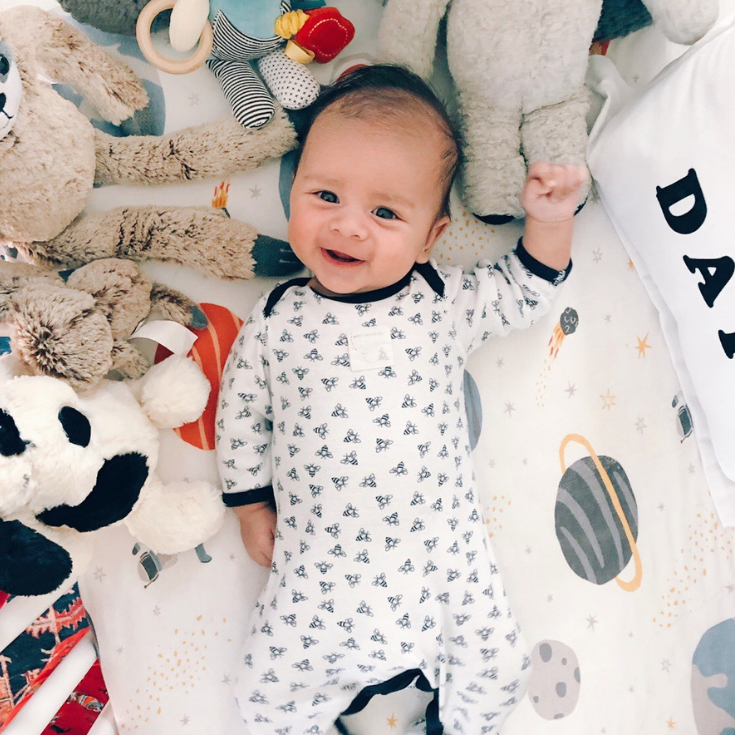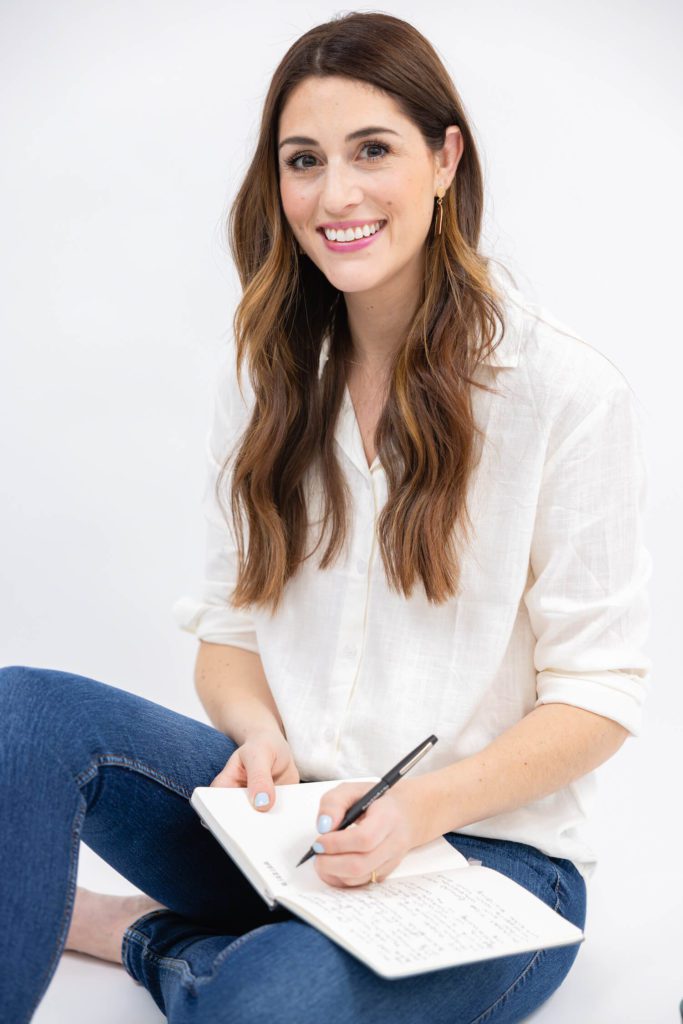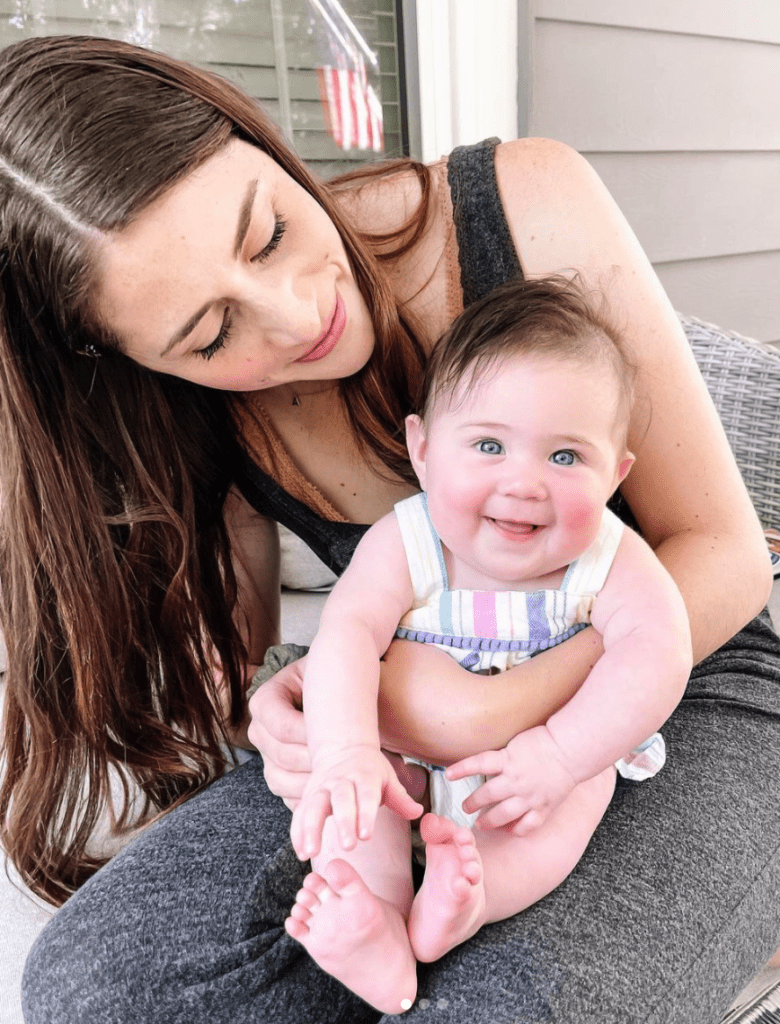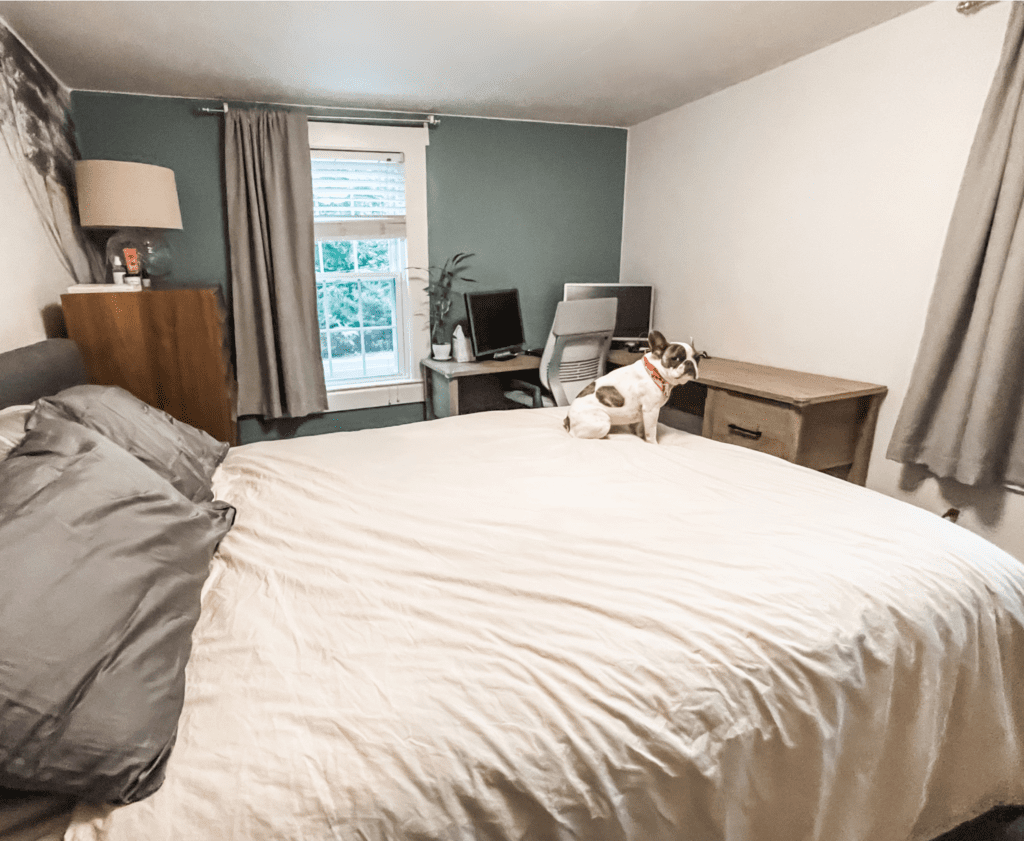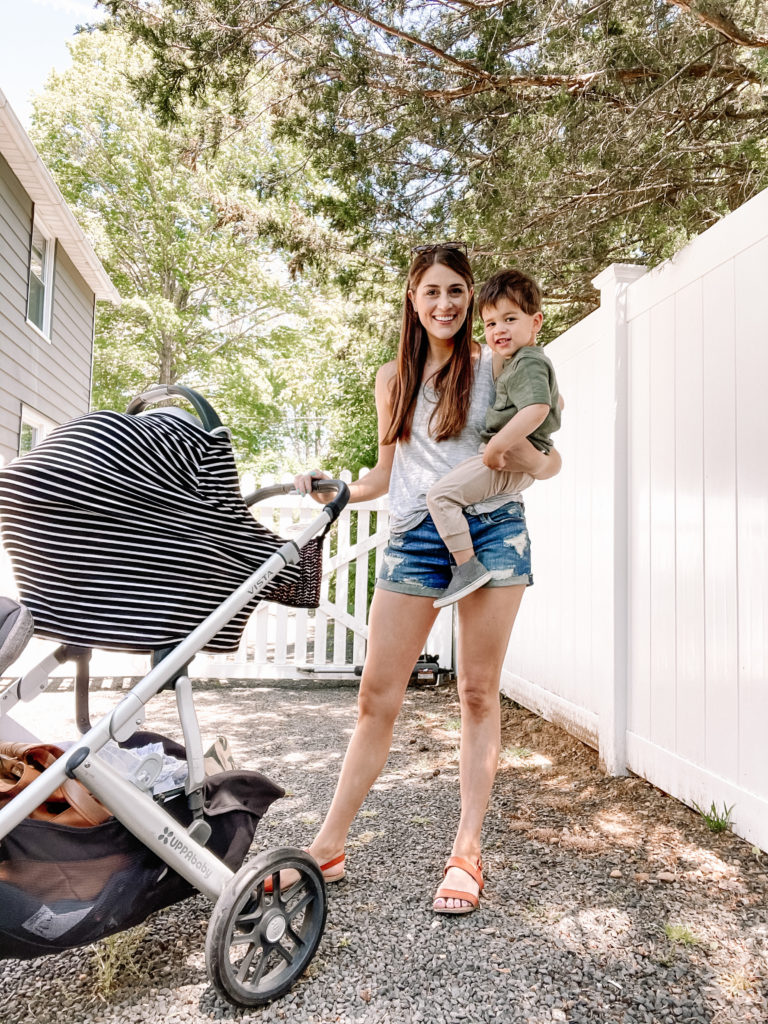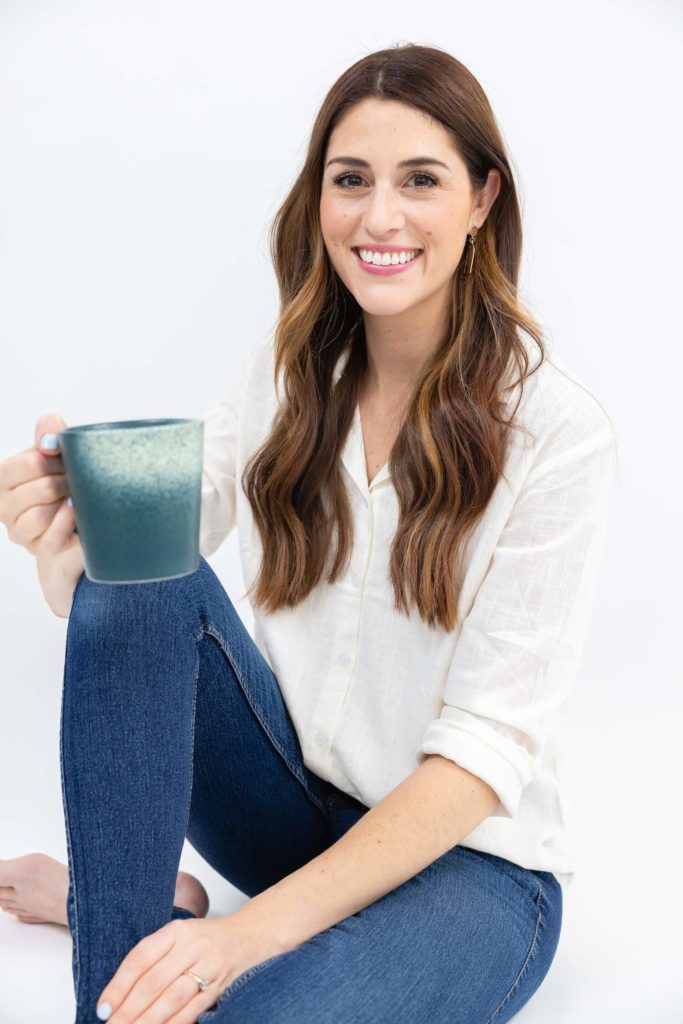
I’ve shared so much of Miles’ sleep on Instagram but never sat down to write an entire post. Baby sleep is wild. And I wouldn’t say I gave birth to the most amazing sleeper on the planet. The truth is, baby sleep can be a little bit of a rollercoaster from amazing weeks to weeks where you wonder if you’ll ever sleep past 4:45am again.
Miles’ sleep is at a place now where I’d call it “pretty dang good,” but it sure isn’t perfect. And, since this baby sleep rollercoaster never totally comes to a complete stop, it seemed hard to sit down and write a blog post about it. Not to mention, surviving one year of baby sleep with one baby doesn’t exactly make me an expert by ANY means.
But I wanted to take the one-year mark as a chance to stop, reflect, and share our baby sleep journey for the first year. I’ll share what we did: what worked, what didn’t, and any other tidbits of advice I can offer. My hope is you can get something out of it that might help your little one, or if nothing else, feel less alone next time your precious angel wakes you up at 5am.

Months 1-3
There really isn’t much you can do in the way of baby sleep at first besides just jump on and enjoy the ride. Babies (and their feeding schedule) pretty much dictate it all. But there are some things you can do the help lay a good foundation for later sleep AND things to help a fussy baby fall asleep.
Morning Vs. Night
The one thing we did right away was trying to help Miles understand the difference between morning and night to start to set him up for later sleep success. I didn’t go crazy, but for nighttime feedings I kept the lights very low. I kept interaction/talking/singing to a bare minimum. Then, when morning came I turned on all the lights. I talked to him a lot. I played music. I made sure the house stayed bright all day — even though it was October and November. In the womb, there is no night and day, and this helped Miles’ internal clock get on the same page with the outside world. And it definitely worked. While Miles isn’t the world’s best sleeper, he’s always been pretty good about cueing in that nighttime is approaching, even from the very early days.
The “Will I Ever Sleep Again Course”
When Miles was about a week old I bought the Taking Cara Babies “Will I Ever Sleep Again” program and I CANNOT RECOMMEND IT ENOUGH. As a new mom, it was everything I needed. It not only broke down the science and progression of baby sleep, but she gives real-life, attainable steps to make co-existing with a baby SO MUCH EASIER. Most importantly the course gave me the confidence to say “I know what I’m doing” when it came to Miles’ sleeping schedule, how much he should be sleeping, how to help him sleep, how to know when he was sleepy, etc.
She shares a lot of simple baby sleep ideas you may have heard before like “The 5 S’s,” the “Eat, Play, Sleep Routine,” and the idea of “tanking up on milk” during the day. But then she takes that information and shares it in such a way that makes it so accessible.

The 5 S’s
The 5 S’s are magical. PURE MAGIC. They are 5 simple things that help your baby relax and fall asleep. In general, all of them mimic life inside the womb. If you don’t know what they are, they include:
- Shushing: white sound/sound machine, actual shushing with your mouth. Inside the womb is LOUD, like a vacuum constantly running. Life earthside is quiet. A white noise machine is your BFF with a baby. I also HIGHLY RECCOMEND a portable one to take to the grocery store, use on car rides, or clip on near them when they are in the swing in the living room. Trust me, you’ll use the HECK out of it with your newborn and beyond (Miles still falls asleep in minutes if I put on white noise in the car).
My Two Must-Have White Noise Machines: One for the nursery and one for on the go.

- Swaddling: Swaddling your baby for sleep helps mimic the closeness of the womb and prevents the moro reflex. Moro reflex is that thing babies do in their sleep where they jolt their arms forward almost as if they are falling. It never used to interupt baby sleep before because we used to put babies on their bellies to sleep and the crib mattress would naturally prevent the moro reflex. With new, safer back sleep, it becomes a problem because the moro reflex wakes your baby from a sound sleep. Being swaddled prevents this.
Note: Many parents think their babies hate (like HATE HATE HATE) being swaddled, because at first many babies struggle and fuss when they get swaddled. But, I urge you to try the swaddle and combine it with other things from the 5 S’s before giving up. I also suggest you watch some videos on the 5 S’s to see it in action and it will at least inspire you enough to try it out. And once you do, and it works, you’ll be hooked.
My Favorite Swaddles

- Swinging: Rocking or swinging your baby to sleep comes pretty naturally. And, the reason it works is it helps mimic the movement in the womb. Combine with white noise and swaddling, these three things can often put most babies to sleep.
- Side/Stomach: We don’t want to put babies on their side or stomach for crib or bassinet sleeping as it’s not safe. But, when you’re rocking them, turning them to their side or even placing them on their stomach while you rock them can actually be very soothing to them. Again, it mimics the positions from the womb.
- Sucking: This refers to a pacifier. It’s usually the last “S” to offer but can help to calm over fussy babies.
Teaching baby to put themselves to sleep
A big part of the Taking Cara Babies “Will I Ever Sleep Again” program focused on helping your baby fall asleep on their own. It’s a no-cry program for the first three months of a baby’s life. But it teaches you how to help lay foundations for good sleep later, and helping your baby learn to self-soothe and fall asleep independently is a big part of this.
The main premise around this idea is that babies, like adults, have sleep cycles. We all wake many times a night. As adults we barely even know it happens. If your baby falls asleep in your arms but awakes in their crib they’ll be very confused and probably upset — just like if you fell asleep in your bed and woke up in your living room. But, if they fall asleep in their crib and wake up in their crib, they are more likely to connect their sleep cycle and fall back asleep.
The course obviously goes into a lot more detail, but in general, it’s about getting your newborn drowsy but not asleep, and then laying them down. This way they learn how to fall asleep on their own and are not reliant on a crutch like rocking or being held to fall asleep. Of course, you can use rocking and holding to calm your baby and get them sleepy, but you want to try to always place them down when they are still awake and allow them to enter dreamland on their own.
(NOTE: This obviously isn’t for every sleep. Newborns sleep a lot. Sometimes baby will fall asleep in the car seat. Sometimes they’ll fall asleep in your arms, sometimes they literally WILL NOT fall asleep without your help. That’s fine. It’s just about trying to put your baby down awake but drowsy 1-3 times a day to start to build the foundation.)
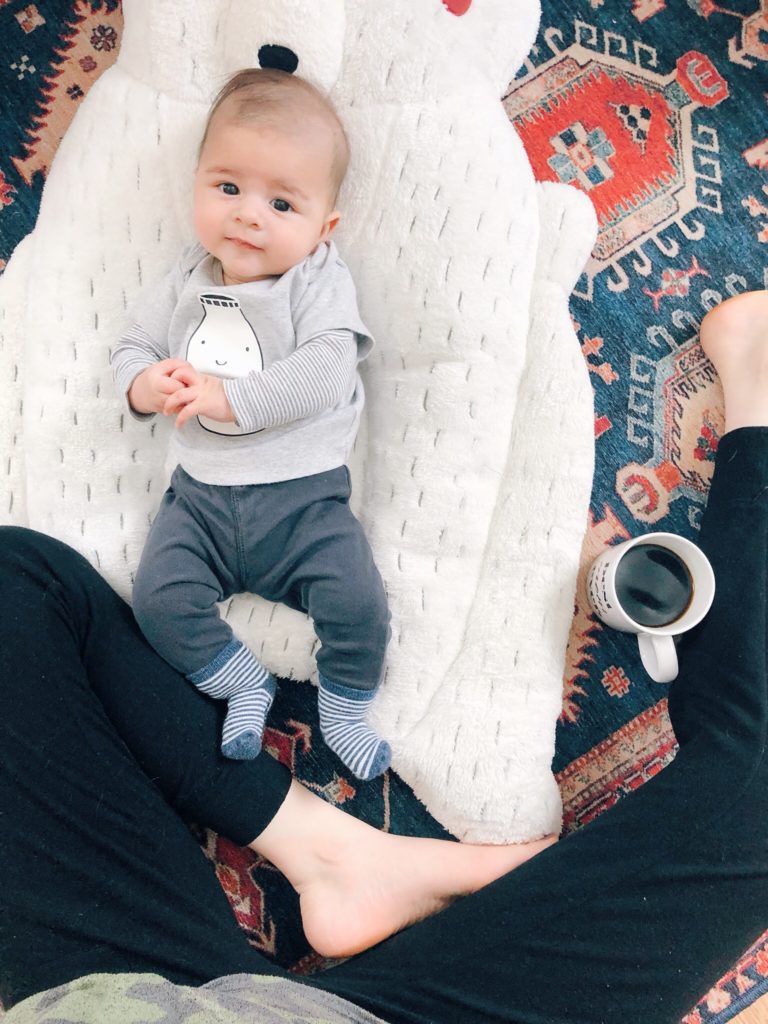
Month 4 – Sleep Regression
Month 4 marks the first sleep regression your baby might go through. Luckily, it’s the only one we’ve hit (or we’ve hit others but thanks to sleep training we’ve endured them). At month 4 your baby’s sleep pattern actually changes. This suddenly makes it harder for them to connect their sleep cycles and, thus, they wake up a lot more through the night. In Miles’ case he went from waking 1-2x to eat (he was a very good newborn sleeper) to waking 4-8x times a night. We were, obviously, very confused. And very tired.
Use The Least Amount of Intervention Necessary
You can do what you believe is right, but most of the things I read suggested waiting on formal sleep training until 5+ months. Babies just aren’t developmentally ready before that. They are still BABIES; they need their parents. They need to be coddled and loved. In my opinion, you can’t over coddle a newborn.
That being said, what are you to do when your baby wants to be coddled all night long?! I used what I called “The Least Amount of Intervention Necessary” method. I would slowly offer intervention to help him back to sleep starting with the lowest amount and working my way up. It’d look like this.
- Miles wakes up crying
- I’d start by turning his sound machine up a little louder. I’d wait 60 seconds.
- If he was still crying I’d try adding movement by rocking his bassinet. I’d try this for 60-120 seconds.
- If he still was crying I’d put my hand on his chest. I’d wait another 60 seconds.
- If he was still crying I’d offer his pacifier. I’d do all 4 of these things (louder sound machine, rocking, touching, and pacifier) for 2-3 minutes.
- Usually, he’d at least start to calm down. As he settled, I’d slowly remove each thing first by taking away my hand, then stopping the rocking, then lowering the sound machine slightly.
Keep in mind the goal wasn’t to get him totally asleep but calm enough and super drowsy. I did want him to fall asleep on his own without rocking/my touch so that he didn’t need these things as a crutch to fall asleep.
Each time I’d follow that same routine. It was just a few simple steps that I remembered in my mind so when I was tired and half-awake it was easy to follow: Sound, rocking, touch, pacifier — each with 60-120 seconds in between.
If all of this failed, I’d usually say, “OK, must be time to eat.” I did know Miles usually only ate 1x a night at this point, however. So, if it wasn’t a normal feeding time for him, I wouldn’t just rush to it. I’d stick to my least amount of intervention until he was asleep.
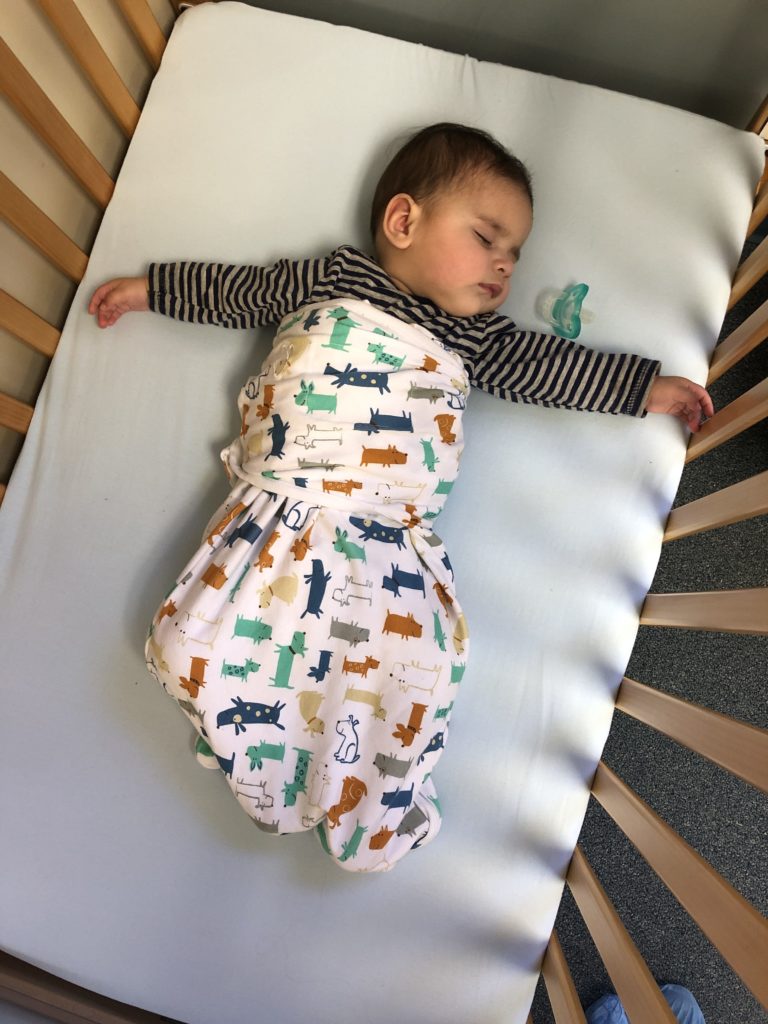
Transitioning from the Swaddle
It’s a bit of a blur, but I believe between 3-4 months is when we transitioned from the swaddle. Miles had started to show some signs of rolling onto his belly soon (a sign it’s time to stop the swaddle) and I didn’t want to wait until it was too late and have to go cold turkey. Of course, transitioning from a swaddle plus sleep regression wasn’t the most fun combo ever.
I tried the “one arm out” method at first, but it didn’t go well at all. Miles was very big on his swaddle and one arm out was way too distracting. He couldn’t sleep. I ended up opting for Merlin’s Magic Sleep Suit. This thing is a ridiculous puffy suit that looks like your baby is about to fly to Mars. We called it his astronaut suit. But, basically, it provides the feeling and closeness and security that the swaddle does, while allowing some movement to their arms. For Miles, a baby who loved the swaddle, it was the perfect in-between.
Products we used to transition from swaddle:

I started by using it just for naps for 3-4 days. Then, I started doing it at night. If he had a rough wake up in the middle of the night, and couldn’t get back to sleep, I’d swaddle him. After about 3 weeks we were able to do away with the swaddle altogether. Then, around 5 months (again guys, it’s a blur, my timing could be off) we started to move him to a sleep sack. I started with the halo sleepsacks, these are swaddles that you can use arms out. It allows his arms to be free but you can still swaddle across the chest, giving that last little feeling of closeness and security. Again, I started with these at naps and continued the Magic Sleep Suit at night. Eventually, I started them for nighttime sleep. Then, around 6 months I went to just plain sleep sacks and that’s what he’s been in since.
Months 5-7: Sleep Training
We attempted to start sleep training at around 5 months, but Miles got back to back sick and then we went on a vacation to Florida, so it really just wasn’t the right time. We did a formal sleep training at about 6 1/2 months instead.
So, what the heck is sleep training? It’s not just putting your baby down and letting them cry it out. It’s just about setting a routine into place. This can be different for different families and babies and what you’re comfortable with. The truth is there is A LOT of information out there. A lot of methods. A lot of “do this” and “don’t do that.” I opted to hire a sleep coach because I wasn’t sure how to navigate it all. Also, I’m the kind of person that does best when I have someone to talk things out with — I tend to overthink things. By opting for a sleep coach I knew I’d have someone to talk to every day during sleep training to reassure me I’m doing it right.
We used The Cradle Coach and did the “telephone plan.” It started with a long written assessment about Miles, our family, his schedule, how much crying we were comfortable with, an assessment of his sleeping area, etc. Then, our coach wrote us a custom plan for us.

Our Sleep Plan:
The Sleep Training Method: What I liked about doing a custom sleep plan was it allowed us to pick something we were comfortable with. Our method involved limited crying — if Miles was full-on crying (what we called Level 9 or 10 crying, like if you were going to rank his level of cry on a scale of 1 to 10) for 2 consecutive minutes we could go in and comfort him.
Just like with my “least amount of intervention” method, the idea was to provide the least amount of support to calm him down. It was a super achievable plan for us because 2 minutes was a length of time we were comfortable with, but it also forced us to pause and wait and really listen to Miles’ cries to know if they were “I NEED YOU” cries or “I’m just fussing” cries. We didn’t feel like we were just letting him cry and cry, but we also felt empowered knowing how to distinguish the sounds of his cries.
Set Naptimes: The plan we opted for included three set nap times (at the same time every day). This went against everything I was doing before – before I just watched his sleepy cues closely and put him down when he seemed tired. This method had worked wonders when he was a newborn, but as he had gotten older his cues had become very hard to read. So, I was willing to try this set nap time option and to my surprise, it worked LIKE A CHARM. Not only did Miles’ natural internal clock start to cue in to the times, but it was sudden freedom for me to know exactly when nap times would be. It made scheduling my day and living my life a lot easier.
Longer times between feeds: The last thing my sleep coach wanted me to do was to push Miles to 4 hours between feeds. She wanted to make sure he was taking good full daytime feeds and not just snacking. Now, if you’re privvy to my breastfeeding journey you know nursing wasn’t a breeze and Miles was never a good eater. Because of this, we’d ended up on a schedule where he was still eating every 2-3 hours (during the day) at 6 months old. I was really nervous about pushing him to 4 hours. We tried to do similar things with my lactation consultant when he was younger and Miles never really caught on. My sleep coach and I compromised at 3 1/2 hours and Miles adjusted great.
And after about a month I actually ended up pushing him to 4 hours between feeds, and he did great. Talk about another bit of freedom in my life! Going from feeding every 2 1/2 hours to 4 hours felt like spring break.
Cutting Nighttime Feeds: The last thing I really liked about this sleep training method is it didn’t require I cut nighttime feeds cold turkey. Miles was still feeding once a night. And because he was not consistently gaining weight at the time, I was hesitant to drop this extra feed. Also, truthfully, I kinda liked our quiet middle-of-the-night feeds. Anyways, with this method, if Miles awoke at his normal feeding time (between 1am-2am) I was able to feed him. And so I continued to do that through sleep training. The plan was to cut that nighttime feed once I knew he wasn’t still losing weight. I was also waiting until August because in July we went on vacation AND moved into a new house. So, once August arrived and we were settled in our new house we also had a checkup for Miles, and he had gone from 9th percentile in weight to the 30-something-th. His naps were great, his nighttime sleep, overall, was good. And so I knew it was time to wean.
I followed a method from Taking Cara Babies. I started by setting an alarm on my phone for about 30 minutes before Miles usually woke to eat. Then, I’d go in and feed him. This way I was the one waking him to eat and it helped him drop the habit of waking himself to eat. Each day I would nurse him for 2 minutes less (if you’re bottle-feeding you can do 1/2 ounce less each time). I went from 14 minutes to 12 to 10…and once I got to 4 minutes I just didn’t set an alarm anymore. It was just as simple as that. When I got down to the shorter times I was worried he’d freak out when I put him down but he never fussed more than 30 seconds or so. And the first night I didn’t set an alarm he didn’t wake up until the morning!
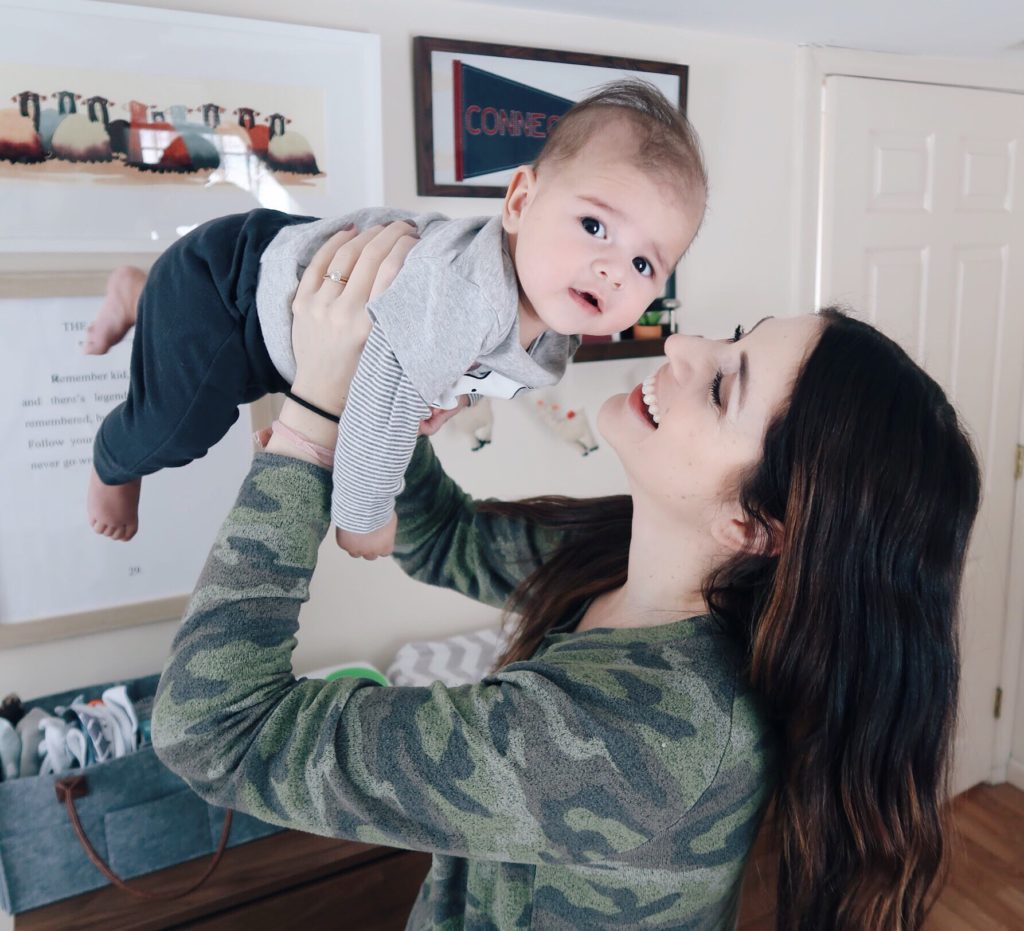
Babies are Babies, Not Robots – So Trust Your Instincts
You might read about sleep training and it’ll tell you your baby should never wake before 6am or should always nap for 90 minutes or *insert some other sleep training mantra here.* And, in theory, these are usually good things to strive for for your baby. You are your baby’s sleep advocate. And sleep is VERY important to your baby’s cognitive development – it’s when all those good connections are made in their brain.
But babies aren’t robots.
They don’t have a little setting in them that says “rise at 6:00am” or “sleep exactly 90 minutes.” While it’s very good to follow some general sleep practices so you can support your baby in getting good sleep and developing good sleep habits, you don’t have to become a drill sergeant either.
You won’t break your baby because you rock them to bed sometimes, you won’t ruin their sleep because you let them get out of bed at 6:05am one morning instead of 6:30am. You’re not a failure because your baby wakes up early or takes a short nap. Your baby is still a baby. They are a tiny human who is doing SO much growing and learning and developing this little personality. Give them grace and give yourself grace.
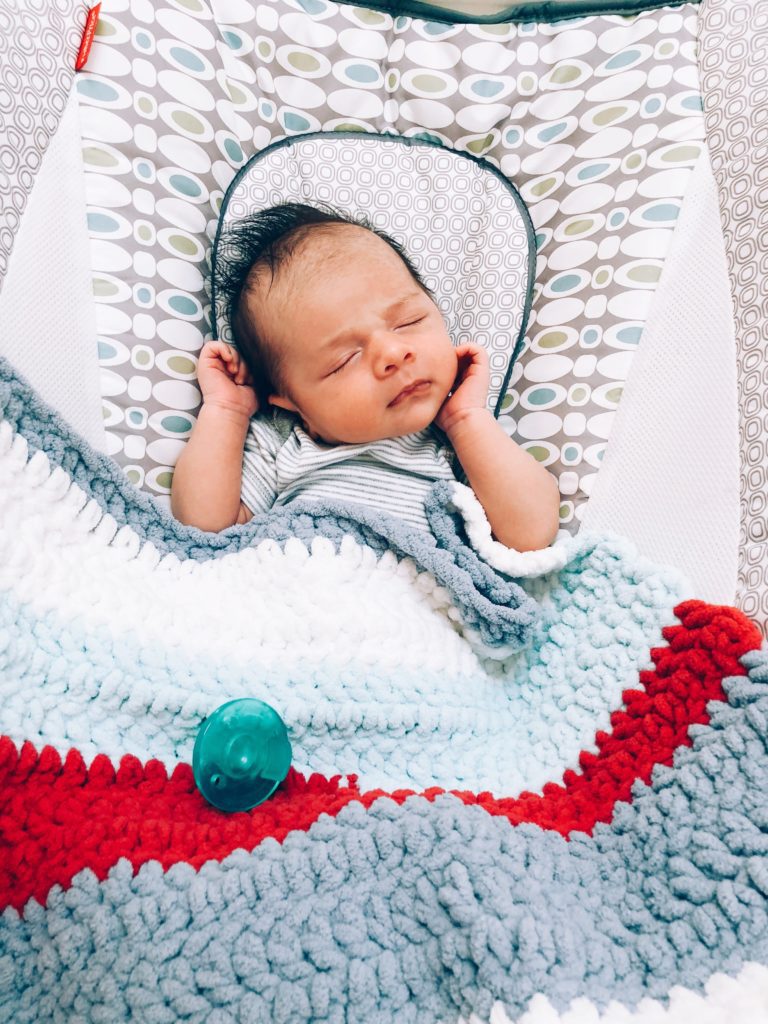
This is just a phase
Baby sleep is NO joke. It will test you. It will confuse you. You’ll be exhausted, confused, and desperate. You’ll spend hours rocking a fussy baby who refuses to sleep. You’ll wonder if you’re doing it wrong. You’ll think every baby is a better sleeper than your baby. You’ll do all these things but the most important thing to remember is THIS IS JUST A PHASE.
Whatever bad sleep your baby is going through right now WILL NOT last forever. While you can do things – like some of the things mentioned above – to help, at the end of the day sometimes it’s just a rollercoaster you gotta ride. I reminded myself A LOT, and still do, that whatever tough thing he’s going through right now is just a moment in his life — a blip on the radar I’ll barely remember in 2 years. Remembering it’s just a phase and will be over soon makes enduring it easier.
I also try to remind myself that any of the good things happening at that age are just a phase too. You don’t get newborn snuggles back again, quiet middle-of-the-night nursing sessions don’t come around again…babies don’t keep. I’d try to focus on the lovely moments of that time and remember they are a phase too — which helped me be more present and soak them up more.
Learn to be your baby’s advocate
I think one of the best things I did was try to educate myself as much as I could. I took courses, hired a sleep coach, and used The Wonder Weeks app to try to learn what, developmentally, Miles was going through. When you take a second to step back and realize the sheer magnitude of things your baby goes through in their first year of life, it really sheds light on their behavior. I found by learning about Miles’ developmental leaps and changes, I was able to sympathize with him. So, when he hit a rough patch I found I was more able to approach it from a place of being his advocate “how can I help you through this change/leap/period” as opposed to his rival “why won’t you just stop crying and sleep?!”
Along with the things mentioned above, I also suggest the book Happiest Baby on the Block.
Well, there you go. My best tips I can offer from surviving a year of baby sleep. Remember, when in doubt, there’s always coffee 🙂

